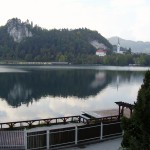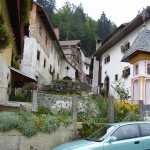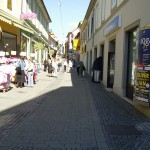Slovenia and Croatia 2005
 The reason for my visit to Slovenia was probably fairly unusual - it was to attend a Japanese conference. The Japanese company with which I have been involved for many years has a European agents conference every two years, hosted by one of the agents, and at a previous meeting someone asked where the next one would be held. "Slovenia", we were told. This met with blank faces. No one, including me, had any idea where it was.
The reason for my visit to Slovenia was probably fairly unusual - it was to attend a Japanese conference. The Japanese company with which I have been involved for many years has a European agents conference every two years, hosted by one of the agents, and at a previous meeting someone asked where the next one would be held. "Slovenia", we were told. This met with blank faces. No one, including me, had any idea where it was.
In fact, it is the northernmost state of the former Yugoslavia, situated between Austria, Italy, Croatia and Hungary. It became independent in 1991, after a very brief struggle, and while some of the other parts of the former Yugoslavia devoted their energy to things like ethnic cleansing, the Slovenians concentrated on building up a decent economy. They had an advantage in that the area was already more industrialised than the states to the south.
The conference was held in Maribor only on a Friday, so I decided to fly out on the Thursday and return on Sunday, which would give me a chance to have a look round. Maribor is a mountain and ski resort in the north east of the country, quite close to the Austrian border.
The only international airport is at Ljubljana, the capital, and I flew from Gatwick with Adria Airways, a small Slovenia airline, arriving at 12.45. After picking up a Citroen C3 Diesel from National Car Rental I set off for Bled, in the north west of the country. Bled is a noted tourist resort, with a lake, mountains and a castle.
My first stop was a town a few miles from the airport called Kranj (pronounced something like Kran-ya) the main feature of which was at first sight a massive communist era factory making resistors, but the town centre was actually quite picturesque. From there, as I had plenty of time I took a real country route to Bled, via a place called Kropa. After quite a long distance there were cones and signs indicating that the road was closed. I had met several big lorries carrying aggregates, so I thought it must be possible to get through, and it was a very long way to go back, so I decided to carry on. It did go through, but when I told some local people about it the next day they said "Didn't you see the red flags? When the road is closed it means that they are blasting at the quarry". Oh, well.
In Bled I found a guest house quite quickly, and went for a look round. It was really beautiful, quite like Switzerland. On the lake there were superbly varnished wooden launches, with big paddles at the stern, and they are rowed along  by old men who are themselves a feature of the place, but, not surprisingly, it is proving to be difficult to find youngsters to take on the task. There were plenty of restaurants still open in the evening in September.
by old men who are themselves a feature of the place, but, not surprisingly, it is proving to be difficult to find youngsters to take on the task. There were plenty of restaurants still open in the evening in September.
The next morning it was pouring with rain and I set off for Maribor, The country has a good network of motorways, but there is a toll, and I am too mean to pay. Also, the free map I had from the tourist office said 'Byways are more attractive than Highways'. The only practical route was to go back to the airport (avoiding the closed road) and then take a cross-country route via a town called Velenje. At one point I branched off on to a long cul-de-sac road to a ski and sports resort in the mountains called Kamnisca Bistrica, but when I got there it turned out to be a privately run venture, and was closed. Anyway, the scenery was good.
It just rained and rained, and I was equipped for a conference, not for wandering about in those conditions, so all I could do was to keep driving. The road ran between mountains of up to 1500m all the way, so it was picturesque, if a bit depressing. Some time after stopping for a snack I came to a place called Oplotnica, and the map, which was about 6 miles to the inch, showed a mountain road from there to Maribor. The route proved to be far more complicated on the ground than it appeared on the map, and not long after entering a forest the road began to deteriorate. It started to go downhill, literally, and turned into a muddy track, with bits of wood all over it. I had serious doubts about whether I could get back up the hill, so I decided to keep my nerve and carry on. The hill got steeper, but eventually, to my immense relief, the road got better and came into a village. This was certainly not the road shown on the map, but it did lead to Maribor and the conference centre.
The conference the next day was what such conferences always are, people whose English is not very good trying to communicate technical material to other people whose English is not very good.
 In the evening we were taken by coach into Maribor for a meal. The coach was left in the centre and we walked (about 40 people) half a mile through a park to the restaurant. When we came out at 10.00pm we walked back through the park. In this situation protocol dictates that the Japanese principals must walk in front, which was not ideal, because they were about 5ft5in tall, and in the park were around 200 youngsters in groups of about 5 or 10 with bottles. Fortunately, we had some big German and Scandinavian men in our group who were the sort of people you wouldn't mess with, so the youngsters responded only with loud comments that we couldn't understand.
In the evening we were taken by coach into Maribor for a meal. The coach was left in the centre and we walked (about 40 people) half a mile through a park to the restaurant. When we came out at 10.00pm we walked back through the park. In this situation protocol dictates that the Japanese principals must walk in front, which was not ideal, because they were about 5ft5in tall, and in the park were around 200 youngsters in groups of about 5 or 10 with bottles. Fortunately, we had some big German and Scandinavian men in our group who were the sort of people you wouldn't mess with, so the youngsters responded only with loud comments that we couldn't understand.
The conference centre was a sports hotel at the foot of a mountain with a gondala to the summit, and they had  mountain bikes that were free for guests to use. Over the meal a Swede named Roger said he would quite like to ride down the mountain the next morning, so I said I would join him. By morning it had stopped raining at last, and as we were getting ready after breakfast a Swiss bloke named Mario decided to come with us. Out of about 15 bikes there were only two decent ones, one large and one small, which Roger and I had already got, so Mario finished up with one with no back brake, but he said it didn't matter because he had been riding down mountains in Switzerland since he was 10.
mountain bikes that were free for guests to use. Over the meal a Swede named Roger said he would quite like to ride down the mountain the next morning, so I said I would join him. By morning it had stopped raining at last, and as we were getting ready after breakfast a Swiss bloke named Mario decided to come with us. Out of about 15 bikes there were only two decent ones, one large and one small, which Roger and I had already got, so Mario finished up with one with no back brake, but he said it didn't matter because he had been riding down mountains in Switzerland since he was 10.
The chairman of the Japanese company was very worried, because he thought he was on the point of losing three agents, but we brushed his concerns aside and went up the mountain. I must admit that on the way down I couldn't keep up with the other two, who were at least 20 years younger than me, but we survived.
After the bike ride I went into Maribor for a look round. It is the second largest city in Slovenia, and the central area is clean and tidy with many well preserved old buildings. There was a market with stalls offering all kinds of food, and a lady persuaded me to buy a piece of thick bread with a slab of white stuff on it. I asked her what it was, and she said "Fett". Several other people joined in and said "Fett", which I knew to be German for lard in that context. Not the sort of thing to eat too much of, but having bought it I had to eat it.
I then set off for Croatia, which was only about 30 miles. At the border there was a queue of lorries because it is an EU frontier, but I drove slowly past them on the wrong side of the road, and showed my papers to the person at the check point. On the Croatian side there was a massive amount of civil engineering work, mainly road-building. Shortly after the frontier I turned off into the mountains, and as the road climbed I looked down on to a village or small town below. It was amazingly different from anything I had seen in Slovenia, with Soviet-style concrete blocks of flats, and had the appearance of being very run down.
The intention was to take a route over the mountains for about 40 miles, and cross back into Slovenia at the second frontier post from where I had come in. In fact, my map was nothing like detailed enough, as I found before, and after about 10 miles I found myself in a tiny village with no way through. To turn round I had to reverse into a steep downhill side road, and had great difficulty in persuading the car to start on the hill. This somehow upset the engine management, and when I got on to the level road at the top it would only do about 10mph. After standing for a while it recovered, to my considerable relief. It would not have been a good place to break down.
Eventually I found my way over the mountain, and stopped at a restaurant by a river a few miles from the border, and ordered some coffee and cake. While I was waiting I suddenly realised that I had no Croatian money, and had visions of being thrown into a filthy rat-infested jail and left to rot. However, the waiter reluctantly agreed to accept Slovenian money, and I went on my way.
From there I was heading back towards Ljubljana on a less mountainous route than I had taken the other way, and found a small country hotel with a restaurant for my night stop.
The next morning I set off for the Technical Museum at Bistra, which has a very good collection of cars, including most of the ones used by General Tito. They are much more varied than might be expected, because many of them were given to him by different governments trying to get him on their side.
From the museum I went on to Ljubljana, and had plenty of time to look round the city centre before going on to the airport. It was larger and more imposing than I expected, and I was just in time to look round the Sunday morning antique market.
Overall I was very impressed with Slovenia. It seems to have a sensible government and sensible people, who are prospering as a result. One quite noticeable thing as you go around is that every town or village appears to have a factory or some other source of employment, which is how it used to be in Britain.